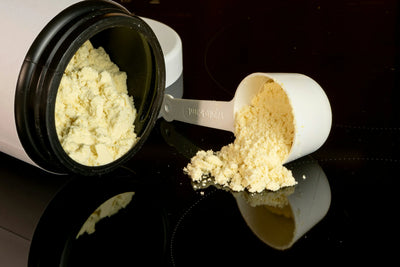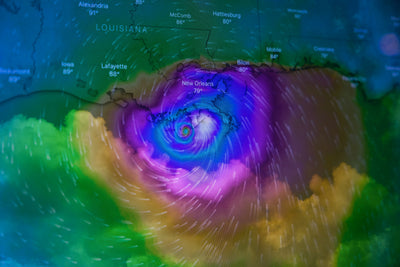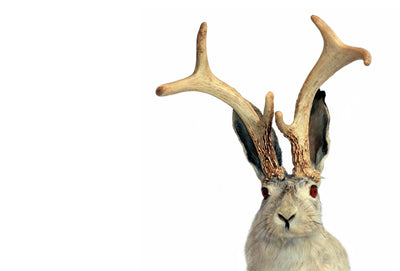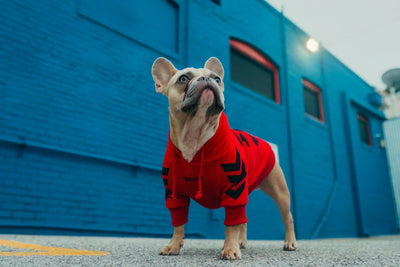Introduction
Want your dog to have a fit and energetic life? A scientific approach to muscle building will not only make your dog look stronger, it will also improve their health, athleticism and even make them more confident and happy in their daily lives.
Building Muscle Mass in Dogs: 5 Science-Backed Diet & Exercise Tips
Whether it's an energetic companion that accompanies you on a run or a furry child that's been prancing around the park, a sensible diet and exercise program can help them be at their best. Below, we'll give you details of five science-based diet and exercise recommendations to help your dog build healthy muscle and rejuvenate!

1. Science-Based Diet: A Solid Foundation for Muscle Growth
Just as human fitness requires scientific nutritional support, the first step to building muscle in dogs is to create a balanced diet program. Reasonable nutritional intake not only provides raw materials for muscle growth, but also supports overall health and gives your dog more motivation during workouts.
(1) High Protein Foods: The “Building Blocks” of Muscles
Protein is the core of muscle growth, providing your dog with the amino acids needed to repair and build muscle. Choosing high-quality, easily digestible protein sources will help your dog's muscles grow more efficiently. Here are some quality protein foods for dogs:
Chicken: Chicken breasts are an excellent low-fat, high-protein choice that is easy to digest and suitable for most dogs. Skinless and boneless, they are delicious and nutritious when cooked.
Beef: Rich in iron and zinc, it not only supports muscle growth but also prevents anemia and keeps your dog energized.
Fish: Fish rich in omega-3 fatty acids, such as salmon or cod, not only helps muscle repair, but also improves joint health, especially for dogs who exercise a lot.
Eggs: Hard-boiled eggs are an economical and efficient source of protein, and the nutrients in the yolks also add shine to your dog's coat.
It is recommended to adjust the proportion of protein intake daily according to your dog's weight and activity level, and consult your veterinarian to determine the optimal amount to feed.
(2) Healthy fats: a source of energy and shine
Fats are not only the main source of energy for your dog's activity, but also make their skin healthier and coat shinier. Adding healthy fats in moderation will keep your dog energized while building muscle. The following fat sources are recommended:
Fish oil: rich in omega-3 fatty acids, it reduces inflammation and is especially good for dogs who exercise regularly.
Chicken oil: added in small amounts can enhance food palatability while providing high-density energy.

Olive oil: A few drops of olive oil in dog food occasionally can add a healthy flavor to your dog's diet.
Pay attention to controlling fat intake to avoid excessive weight gain, which will affect muscle building.
(3) Vitamins and minerals: overall support of health
Vitamins and minerals play an important role in muscle synthesis, repair and overall metabolism. Here are some key nutrients:
Calcium and phosphorus: strengthen bones and teeth, providing solid support for your dog's exercise.
Vitamins E and C: act as antioxidants to protect muscle cells from oxidative damage associated with exercise while boosting the immune system.
B Vitamins: support energy metabolism and give your dog more energy during exercise.
These nutrients can be supplemented with natural ingredients (such as green vegetables) or high-quality dog food to ensure a balanced diet for your dog.
(4) High-quality carbohydrates: a stable supply of energy
Carbohydrates provide a constant supply of energy for your dog's daily activities and exercise, and are a part of the diet that cannot be ignored. Choosing carbohydrates with a low glycemic index can avoid energy fluctuations and keep your dog stable:
Brown rice: rich in fiber, it provides slow-release energy for prolonged activity.
Oats: not only are they easy to digest, they also promote intestinal health.
Sweet potatoes: rich in vitamin A and dietary fiber, they are a delicious and nutritious source of energy.
Adding these ingredients to your dog's diet in moderation will give them more stamina during exercise.
2. Scientific Exercise: Let the Muscles Really “Move” up!
Diet provides raw materials for muscle growth, while scientific exercise is the key to make your dog's muscles strong. Through the combination of aerobic exercise, strength training and explosive force training, the dog's physical fitness and body shape can be significantly improved.
(1) Aerobic Exercise: Enhance Cardio and Endurance
Aerobic exercise improves your dog's cardiorespiratory fitness and overall endurance, laying the foundation for subsequent strength training. Below are two suitable aerobic exercises:
Jogging: Taking your dog for a 30-60 minute jog at an even pace every day not only strengthens the cardiorespiratory fitness, but also improves the understanding between you. Choose flat grass or paths to protect your dog's joints.
Swimming: Swimming is a low-impact, full-body workout, especially for dogs with sensitive joints. Whether it's a lake or a pet pool, swimming allows your dog to exercise their entire body while having fun.
Remember to gradually increase the duration and intensity of the exercise according to your dog's size and stamina to avoid overworking.
(2) Strength Training: Building a Strong Body
Strength training can directly stimulate muscle growth and enhance your dog's strength and coordination. Here are two simple and effective methods:
Rally: Use a sturdy rope or toy and play a pulling game with your dog. This not only works their bite and limb muscles, but also adds to the interactive fun.
Backpack training: dress your dog in a specialized training backpack and gradually increase the load (starting at 1-2% of their body weight) to allow them to exercise their muscles while walking or jogging. Observe your dog's reaction to make sure the weight is appropriate.
Strength training should be gradual, avoid increasing too much intensity at once.
(3) Explosive Strength Training: Stimulate Muscle Potential
Explosive strength training stimulates the growth of fast muscle fibers and improves athletic agility. Here are two interesting training methods:
Running back and forth: Set up a distance of 10-15 meters in a park or open space and use toys or snacks to guide your dog to run back and forth quickly. This improves their explosive power and agility.
Jumping training: Set up a 15-30cm high obstacle (such as a small hurdle or board) and encourage your dog to jump. Not only does jumping work the leg muscles, but it also gives your dog more energy.
After each training session, remember to give your dog plenty of rest and rewards to keep them enthusiastic about exercise.
3. Precautions: Making Muscle Building Safer and More Effective
A scientific muscle building program requires care and patience, here are some key considerations:
Avoid overfeeding: too much food may lead to obesity, offsetting the effect of muscle building. Strictly control your daily intake and follow the principle of “small amount, many meals”.
Exercise moderately: Excessive exercise may lead to muscle strain or fatigue. Observe your dog's condition and take breaks when you feel tired.
Regular check-ups: Before starting a new diet or exercise program, take your dog to the veterinarian for a check-up to make sure they are fit for muscle building. Regular medical checkups can also identify potential health problems in a timely manner.
With a scientific diet and exercise program, your dog will not only have strong muscles, but will also glow with more energy and confidence. Whether it's exploring the outdoors with you or romping around the house, a healthy dog always adds to the fun of life. Before implementing any new program, remember to consult a professional veterinarian to make sure the diet and exercise regimen is right for your dog. Let's work together for the health and happiness of our fur kids!
Why Is My Dog Losing Muscle Mass? Common Causes & Solutions
When you notice that your beloved dog has become less energetic than before, their stride seems weak, or even their muscles feel flabby to the touch, you may feel worried and confused. Muscle loss (also known as muscle atrophy) in dogs not only affects their mobility, but can also reduce their happiness and quality of life. Muscle loss can be caused by a variety of reasons, but the good news is that with scientific intervention and careful care, you can help your dog regain a strong physique. Below, we'll take an in-depth look at the common causes and symptoms of muscle loss in dogs, as well as practical solutions to help rejuvenate your furry child!
1. Common Causes of Muscle Loss in Dogs
Muscle loss is not a single problem, but the result of a combination of factors. Understanding these causes can help you find targeted solutions.
(1) Ageing: a natural challenge
As a dog ages, the body's ability to metabolize protein diminishes and muscle tissue is slowly lost. Older dogs are often less active and prefer to stay on the couch in the sun, a lifestyle that may further exacerbate muscle atrophy. Just like humans, dogs in “retirement” need extra attention to stay healthy.
(2) Poor Nutrition: Insufficient Fuel for Muscles
If your dog's diet lacks sufficient protein, branched-chain amino acids (BCAAs) or HMB (beta-hydroxy-beta-methylbutyric acid), muscle synthesis and repair will be compromised. Long-term nutritional imbalance may cause your dog's muscles to gradually “shrink” and even affect overall health.
(3) Insufficient activity: the consequences of lack of exercise
Dogs naturally love to run and jump, but if there is a lack of exercise for a long time, the muscles do not get enough stimulation, and they will gradually atrophy. Whether it's limited space for urban living or a busy owner with no time to walk the dog, a sedentary lifestyle can cause a dog's muscles to lose their vitality.
(4) Chronic diseases: an invisible threat to health
Certain chronic diseases, such as heart disease, kidney disease or cancer, can accelerate muscle breakdown. For example, heart disease may lead to metabolic disorders that reduce the supply of nutrients to the muscles, while kidney disease may cause protein loss. These diseases overwhelm the dog's body and muscle loss ensues.
(5) Joint problems: a knock-on effect of limited mobility
Diseases such as arthritis or hip dysplasia can be painful for dogs, causing them to be less active or even reluctant to get up. Over time, the lack of movement can lead to muscle atrophy, especially in the hind legs and back area.

(6) Hormonal imbalance: The body's “chain of command” is out of whack
Hormonal problems such as abnormal thyroid function (e.g., hyper or hypothyroidism) or hyperadrenocorticism (e.g., Cushing's disease) can interfere with your dog's muscle metabolism and lead to muscle loss. These problems often require specialized diagnosis and treatment.
(7) Drug side effects: the invisible “muscle killer”
Long-term use of corticosteroids (e.g., drugs for allergies or inflammation) can lead to muscle atrophy. While these drugs may relieve some symptoms, the side effects may pose a threat to muscle health.
2. How to Recognize Muscle Loss in Dogs?
Muscle loss doesn't happen overnight, and knowing the following symptoms can help you recognize the problem in time:
Mobility problems: Your dog may seem to walk stiffly, be reluctant to climb stairs, or seem to struggle when getting up.
Weight loss: Muscle loss can lead to weight loss and bone contouring becomes more pronounced, especially in the spine and hips.
Lack of energy: A once playful dog becomes lethargic, unwilling to chase a ball or romp.
Changes in muscle touch: muscles feel flabby or weak when petting your dog, especially in the leg or back area.
If you observe any of these signs, it is recommended to take your dog to the doctor as soon as possible to get to the root of the problem.
3. Scientific Approaches to Addressing Muscle Loss in Dogs
Muscle loss is worrisome, but with scientific diet, exercise and medical intervention, you can help your dog gradually regain its health. Here are five practical solutions:
(1) Optimize Diet: Fueling the Muscles
A healthy diet is the cornerstone of muscle recovery. Here are some key adjustments:
Increase protein intake: Choose high-protein foods such as chicken breast, beef, salmon or hard-boiled eggs to provide muscles with the amino acids they need to repair. High-quality dog food can also be a convenient option.
Supplement with key nutrients: Branched Chain Amino Acids (BCAAs) and HMB help promote muscle synthesis and can be added through specialized pet supplements (consult your veterinarian).
Weight control: Avoid overfatting or overthinning your dog to maintain an ideal body shape. Being too fat will increase the burden on the joints, while being too thin may exacerbate muscle loss.
(2) Moderate Exercise: Awakening Muscle Vitality
Exercise is an effective way to stimulate muscle growth, but it needs to be tailored to your dog's health:
Low-intensity aerobic exercise: 30 minutes of jogging or walking every day can enhance cardiorespiratory fitness, improve blood circulation and provide more oxygen and nutrients to the muscles. Swimming is another great option, especially for dogs with sensitive joints.
Resistance training: hydrotherapy or jogging on a gentle ramp gently stimulates muscle growth while reducing stress on joints.
Exercise should be gradual and observe your dog's response to avoid overexertion.
(3) Disease management: Solve the problem from the root cause
For chronic diseases or joint problems, timely treatment is the key:
Control of chronic diseases: control the progression of diseases such as heart disease and kidney disease through medication or dietary management (e.g. low-protein diet for kidney disease) to reduce the damage to muscles.
Joint care: supplementation with glucosamine, chondroitin or omega-3 fatty acids to relieve joint pain and encourage your dog to be more active. Physical therapy or acupuncture may also be effective options.
(4) Medication modification: Reduce the impact of side effects
If your dog is taking corticosteroids or other medications that may cause muscle loss, consult your veterinarian if the dosage can be reduced or replaced with an alternative medication. Professional guidance can help balance the effects of treatment with the health risks.
(5) Regular checkups: prevention is better than cure
Taking your dog for regular checkups can help detect hormonal imbalances, chronic diseases or other potential problems. Your veterinarian can develop a targeted treatment plan through blood tests or diagnostic imaging. Early intervention can often significantly improve muscle loss.
Muscle loss in dogs can be heartbreaking, but by understanding the causes, recognizing the symptoms and adopting science-based solutions, you can help them become strong and happy again. Whether it's adjusting diet, adding moderate exercise, or treating an underlying condition in a timely manner, every step of the way demonstrates your love and responsibility for your furry child. Before starting any new program, remember to consult with a professional veterinarian to make sure the solution is right for your dog. Let's work together to keep your dog energized and happy every day!
Old Dog Losing Weight and Muscle Mass? How to Help Senior Pets Regain Strength
You may feel a pang of heartache as you watch your dog, who has been with you for many years, grow older, with a slower pace, a leaner body, and even flabby muscles to the touch. Weight loss and muscle loss in older dogs is a common problem faced by many pet owners, which not only affects their quality of life, but may also hide deeper health risks. However, with science-based care and a lot of love, you can help your old friend regain his or her vigor and enjoy a happy time in their later years. Below, we'll explore the common causes of weight loss and muscle loss in older dogs, and offer practical solutions to get your furry child back in shape!
1. Why Do Senior Dogs Experience Weight Loss and Muscle Loss?
Physical changes in older dogs are the result of a combination of factors. Understanding these causes can help you take better care of them.
(1) Ageing: a natural “time stamp”
As dogs age, their metabolism slows down, muscle synthesis decreases, and muscle mass naturally decreases. Just as humans tend to lose muscle mass as they age, older dogs face similar challenges. In addition, their appetite may not be as good as it once was and calorie consumption decreases, leading to gradual weight loss.
(2) Malnutrition: Insufficient “fuel” for the body
Older dogs have diminished digestion and absorption abilities and may have a reduced appetite, resulting in inadequate intake of key nutrients such as protein and vitamins. If the diet does not meet the needs of muscle maintenance, muscle loss and weight loss are inevitable.
(3) Reduced activity: energy “sleeps” gradually
Older dogs are often not as active as their younger counterparts, with stiff joints or reduced stamina making them more willing to rest in a corner. Lack of exercise can leave muscles unstimulated, which can lead to muscle atrophy over time.
(4) Chronic diseases: an invisible threat to health
Chronic diseases such as heart disease, kidney disease, diabetes or cancer can lead to loss of appetite, metabolic disorders and even protein loss in dogs. These diseases not only make dogs lose weight, but also accelerate muscle breakdown, affecting overall health.
(5) Joint problems: A chain reaction of limited mobility
Diseases such as arthritis or hip dysplasia can leave older dogs in pain and less willing to move. Whether it's climbing stairs or going for a walk, they may seem overwhelmed, and long-term lack of exercise leads directly to muscle atrophy.
(6) Psychological factors: Emotions affect health
Older dogs are particularly sensitive to changes in their environment, such as moving, new pets joining the family or changes in the owner's schedule, which may make them feel stressed or anxious. Low mood may lead to decreased appetite, which in turn affects weight and muscle health.
2. How to Recognize Weight Loss and Muscle Loss?
Observing the following signs can help you recognize the problem in time:
Weight loss: your dog's ribs or spine become more pronounced, or even bony and prominent to the touch.
Muscle flabbiness: When stroking the back or legs, the muscles feel weak and lack elasticity.
Mobility problems: slow walking, difficulty getting up, or reluctance to climb stairs and play.
Decreased energy: a once active dog becomes quiet and even loses interest in favorite toys or snacks.
If you notice these changes, it is advisable to take your dog to the doctor as soon as possible to find the source of the problem.
3. Scientific Ways to Help Older Dogs Regain Their Vitality
Although weight loss and muscle loss in older dogs is a concern, you can make them strong again through scientific diet, moderate exercise, disease management, psychological care and a comfortable living environment.
(1) Optimizing diet: injecting “vitality fuel” into the body
A scientific diet is the key to helping older dogs regain weight. Here are some practical suggestions:
Increase high-quality protein: Choose easily digestible high-protein foods such as chicken breast, salmon, beef or hard-boiled eggs to provide essential amino acids for muscle repair. High-quality dog food for senior dogs is also a good choice.
Supplement with key nutrients: Omega-3 fatty acids (from fish oil) reduce inflammation and support joint health, while glucosamine and chondroitin help relieve joint pain and encourage your dog to be more active.
Customized diet plan: Every dog's health condition is different. Consult your veterinarian or pet nutritionist to develop a diet plan that suits your dog's needs and ensures balanced and palatable nutrition.
(2) Moderate Exercise: Awakening Muscle and Vitality
Exercise stimulates muscle growth and improves cardiorespiratory function, but older dogs need low-impact, gentle activities:
Low-impact exercise: short walks or swimming for 15-30 minutes a day builds muscle strength while putting little stress on joints. Swimming is especially good for dogs with sensitive joints and is like a “water gym” for them.
Targeted Exercise: Simple sit-to-stand exercises or walking on a gentle incline will strengthen the hind leg muscles. Remember to reward your dog after each session to keep them interested.

Physical therapy: Hydrotherapy, massage or specialized physical therapy can relieve joint pain, improve flexibility and help your dog be more willing to move.
Exercise gradually, observe your dog's response and avoid over-exertion.
(3) Disease management: guarding health from the root cause
For chronic diseases or joint problems, timely intervention is key:
Regular medical checkups: Take your dog for a comprehensive checkup at least once a year to detect potential problems such as heart disease, kidney disease or diabetes in a timely manner through blood tests or imaging tests.
Medication: Use medication to manage chronic conditions or relieve joint pain under the guidance of your veterinarian. For example, non-steroidal anti-inflammatory drugs (NSAIDs) can reduce the symptoms of arthritis and make your dog more willing to move around.
(4) Psychological care: Warm heart support
The emotional health of older dogs is equally important, and a stable environment and full of love can make them feel more secure:
Stable environment: Try to avoid sudden moves or changes in living habits, and keep the dog's familiar routine and rest area.
More companionship and interaction: Spend time walking your dog, stroking their fur, or playing simple games. Your company is their greatest comfort.
(5) Comfortable Living: Make Every Day Easy
Creating a comfortable living environment for your senior dog can significantly improve their health and well-being:
Aids: Set up ramps or non-slip mats in your home to help your dog get up and down stairs or beds easily. Using orthopedic mattresses can reduce pressure on joints and allow them to sleep better.
Warm environment: older dogs are more sensitive to temperature, make sure their resting area is warm and dry to avoid catching cold.
While weight loss and muscle loss in older dogs is worrisome, you can help them regain their health and happiness through scientific dietary management, moderate exercise, disease control, psychological care and a comfortable living environment. Every old dog is a valuable member of the family. They have accompanied us with a lifetime of loyalty, and now it is our turn to return the favor with love and action. Before implementing any new program, remember to consult your veterinarian to make sure the program is right for your dog. Let's work together to keep our fur kids' later years warm and vibrant!





